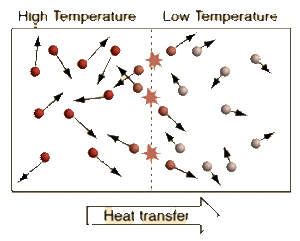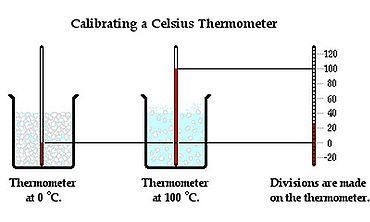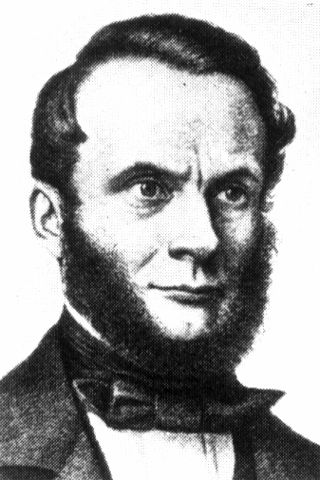Temperature: Difference between revisions
Ayeshaahuja (talk | contribs) |
Ayeshaahuja (talk | contribs) |
||
| Line 136: | Line 136: | ||
[[File:Rudolf_clausius.jpg||Rudolf Clausius ]] | [[File:Rudolf_clausius.jpg||Rudolf Clausius ]] | ||
[[File:Rudolf_clausius.jpg|thumb|center|400px|alt=rudolf clausius|Photo of Rudolf Clausius | |||
==References== | ==References== | ||
Revision as of 12:31, 27 November 2016
Written by Ju Yup Kim
Edited/Claimed by Ayesha Ahuja
Defining temperature

Temperature is measure of average kinetic energy of the particles in a system. Difference between temperature and heat is that heat is the sum of all the kinetic energies of the particles in a system. Adding heat to a system causes its temperature to rise. Newton's zeroth law states that a system reaches a thermal equilibrium when there is no observable change in temperature between a system. Therefore, the change in temperature causes heat to flow from a high temperature system to a low temperature system. When systems with different temperature is in contact, molecules with higher kinetic energy collide with molecules with lower kinetic energy, kinetic energy is passed from the molecules with more kinetic energy to those with less kinetic energy. This molecular level of kinetic energy transfer will happen until average kinetic energy of the particles in each systems reach the average of two.
The relationship between heat transfer and temperature can be modeled with this equation: Q = m c Delta T
Measurement

A thermometer is a device used to measure temperature. It is placed in contact with an object and allowed to reach thermal equilibrium with the object. The operation of a thermometer is based on some property, such as volume, that varies with temperature. For example, mercury in a mercury thermometer expands to a degree depending on a temperature of the object and the level of the mercury in side the glass tube rises or descends. Temperature can be measured in numbers by three temperature scales: Celsius, Fahrenheit, and Kelvin. Celsius scale sets freezing point of the water at zero and boiling point at 100, and Fahrenheit scale sets freezing point of the water at 32 degrees and boiling point of the water at 212 degrees. Kelvin scale is designed to go to zero at absolute zero, the minimum temperature.
The relationship between temperature scales: (degrees)K = 273.15 + (degrees)C (degrees)C = (5/9)*((degrees)F-32) (degrees)F = (9/5)*(degrees)C+32
Thermal Energy and Temperature
The temperature and the thermal energy of an object are both measures of how much kinetic energy is acting on the particles of the material. However, thermal energy is the total kinetic energy of every single particle in the material. Temperature is the average speed of the particles in the material. When the temperature of an object is high the particles move fast and are further apart and when the temperature is low they move slower and closer together. When looking at an more than one object the total thermal energy transferred between two objects of different temperatures is referred to as heat ; generally the transfer is from a hotter to a colder temperature.
Heat Transfer
Heat transfers from objects of lower energy to objects of higher energy. There are three main types of heat transfer: conduction, convection, and radiation. Conduction is seen as the transfer of energy from molecule to molecule. Convection is the energy transferred by the movement and motion of mass. Lastly, radiation is the the transfer of energy by waves.
In physics, conduction is generally the type of heat transfer we focus on. By looking at the formula for thermal energy we can determine the change in energy of a system or the change in temperature of a system.
Examples
(1) On thanksgiving morning your mom cooked a turkey with a mass of 12.55 kg and a temperature of 85°C coming out of the oven. By the time everyone is seated at the table and ready to eat the turkey is now 43°C. Determine the thermal energy of the turkey. The specific heat C for the Turkey is 5.16 J/(gC).
Solution:
[math]\displaystyle{ {∆Ethermal} = {mc∆T} }[/math] where [math]\displaystyle{ {m} }[/math] is the mass of the turkey and [math]\displaystyle{ {c} }[/math] is the specific heat of the turkey and [math]\displaystyle{ {∆T} }[/math] is the change in temperature of the turkey.
[math]\displaystyle{ {∆Ethermal} = {(12.55kg)(5.16J/(gC))(43°C - 84°C) } }[/math]
[math]\displaystyle{ {∆Ethermal} = {-2719.836 J} }[/math]
(2) You take a slice of the turkey (mass: 1.12 kg) at 28°C and place some sauce on top. The sauce has a mass of .044 kg and an initial temperature of 17°C , and a specific heat of 2.2 J/(gC). Looking at the turkey and sauce as a closed system what is the final temperature of the entire system?(T is turkey, S is sauce)
[math]\displaystyle{ {∆Esystem} = {∆EthermalT + ∆EthermalS } }[/math]
[math]\displaystyle{ {∆Esystem} = {m_tc_t(T_f-T_it) + m_sc_s(T_f-T_is) } }[/math]
[math]\displaystyle{ {∆Esystem} = {(m_tc_tT_f-m_tc_tT_it )+ (m_sc_sT_f-m_sc_sT_is) } }[/math]
[math]\displaystyle{ {t_f(m_tc_t+m_sc_s)} = { (m_tc_tT_it) + (m_sc_sT_is) } }[/math]
[math]\displaystyle{ {t_f} = { ((m_tc_tT_it) + (m_sc_sT_is))/(m_tc_t+m_sc_s) } }[/math]
[math]\displaystyle{ {t_f} = { ((1.12kg)(5.16J/gc)(28°C) + ((.044kg)(2.2J/gc)(17°C))/((1.12)(5.16J/gc)+(.044)(2.2J/gc)) } }[/math]
[math]\displaystyle{ {t_f} = {27.576°C} }[/math]
Thermal Expansion
Change in temperature through heat transfer can change the matter to change in shape, area, and volume. When a substance is heated, the kinetic energy of its molecules increases. Then the molecules begin moving more and average separation between molecules become larger, and thus volume of the substance changes. The degree of expansion divided by the change in temperature is called the material's coefficient of thermal expansion and generally varies with temperature and the object and state of matter of the object.
| Material | Fractional expansion per degree C x10^-6 | Fractional expansion per degree F x10^-6 |
|---|---|---|
| Glass, ordinary | 9 | 5 |
| Glass, pyrex | 4 | 2.2 |
| Quartz, fused | .59 | .33 |
| Aluminum | 24 | 13 |
| Brass | 19 | 11 |
| Copper | 17 | 9.4 |
| Iron | 12 | 6.7 |
| Steel | 13 | 7.2 |
| Platinum | 9 | 5 |
| Tungsten | 4.3 | 2.4 |
| Gold | 14 | 7.8 |
| Silver | 18 | 10 |
History
Early explanations of heat were thoroughly confused with explanations of combustion. J. J. Becher and George Ernst Stahl introduced the phlogiston theory of combustion in the 17th century, and phlogiston was thought to be the substance of heat.
In late 18th century, Antoine Lavoisier argued that phlogiston theory is inconsistent and introduced Caloric theory. The suggested explanation was that when an object was heated, an invisible fluid called “caloric” was added to the object. Hot objects contained more caloric than cold objects. Caloric theory was popularly accepted until mid 19th century.
Followed by introduction of caloric theory, Count Rumford found that boring a cannon repeatedly does not result in heat producing ability, and therefore caloric is not lost. This proposed that caloric might not be a substance though the experimental ambiguity in his experiment were widely considered controversial.
In mid 19th century, Rudolf Clausius showed that Rumford's argument and Caloric theory can be agreeable if the caloric theory include the principle of conservation of energy in place of its original principle of conservation of heat. By doing so, the caloric theory was able to be evolved into modern thermodynamics where heat may be put as a thermal energy which is equivalent to kinetic energy of some particles of the substance.
 [[File:Rudolf_clausius.jpg|thumb|center|400px|alt=rudolf clausius|Photo of Rudolf Clausius
[[File:Rudolf_clausius.jpg|thumb|center|400px|alt=rudolf clausius|Photo of Rudolf Clausius
References
http://hyperphysics.phy-astr.gsu.edu/hbase/tables/thexp.html
http://hyperphysics.phy-astr.gsu.edu/hbase/thermo/temper.html
http://teachers.oregon.k12.wi.us/mahr/assignments/thermal_energyvs_temp.pdf
